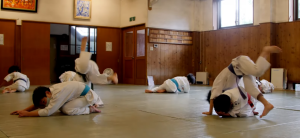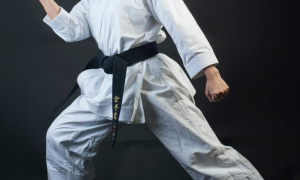Aikido is a contemporary Japanese martial art that prioritises control and harmony over brute force. Developed in the early twentieth century, aikido focuses on neutralising an attacker by using circular movements, leverage, and joint locks. It is a type of self-defence that people of all ages and abilities can practise. Aikido has a spiritual component in addition to its physical aspect, with many practitioners viewing their training as a means of personal growth and development. Aikido is now widely practised all over the world, with dojos (training halls) catering to students of all skill levels. As a result Aikido for kids has become a hot topic with many questions about the less popular martial art and its benefits for young Aikidoka.
Table of Contents
Toggle
Table of Contents
Toggle![]()
Is Aikido Good For Kids? 3 Benefits
1) Self-defence orientated:
Aikido is often viewed as a safe and healthy activity for children because it emphasizes nonviolent conflict resolution and self-defence techniques. Unlike other martial arts Aikido focuses on throws, joint locks, and other techniques that allow the practitioner to control an attacker without causing harm. In the long run, this emphasis on self-control and nonviolence can help children develop important life skills like conflict resolution, empathy, and respect for others.
2) Physical Activity:
In addition to its safety and emphasis on nonviolence, Aikido can provide numerous physical benefits for children. Training is very active, which can help children develop coordination, balance, and flexibility. It can also provide a fun and challenging workout that encourages children to be physically active and healthy.
See the true levels of activeness in this short video of an Aikido class for kids:
3) Discipline:
All martial arts help develop discipline, focus, and self-confidence within children. However, Aikido excels at instilling these qualities within its practitioners. Training requires students to pay attention to both their own and their training partner’s movements. This concentration and discipline can assist children in developing mental clarity, focus, and self-confidence, all of which can benefit their academic and social lives.
![]()
Is Aikido Good for Kids? 3 Drawbacks
1) Physical demand:
Aikido’s type of physical demand may not be suitable for all children. Its’ training includes a lot of movements, such as throws and joint locks, which are taxing on developing young bodies as they lack tendon strength found in teenagers/adults. Children with pre-existing physical conditions, such as joint pain or asthma, may be unable to fully participate in Aikido training. Finding a competent and experienced Aikido instructor is vital for safety and longevity when it comes to kids training Aikido.
2) Expensive:
Aikido can be a relatively expensive activity for kids. While the cost of Aikido training varies depending on the location and instructor, it can be more expensive than other physical activities for kids, such as sports or even other martial arts. This can be a barrier for families with limited financial resources.
3) Lack of Physical Contact:
For some children, the lack of physical contact in Aikido can be a disadvantage . While the emphasis on nonviolent conflict resolution is a positive aspect of Aikido, it may deprive children of the physical challenge and adrenaline rush that more traditional martial arts can provide. Consequently, Aikido may be too passive for children who crave physical activity and competition.
So…. Does the lack of physical contact mean that Aikido is just masquerading as a Martial Art?…. No but it does mean that it has shortcomings when compared to other arts. Especially in the eyes of eager children who are more drawn to action like seen in martial arts such as Karate or Taekwondo.

Summary of Aikido for Kids:
Here is a table summarizing the key pros and cons of Aikido for kids:
Is Aikido a Good Fit for Kids?
| Pros | Cons |
|---|---|
| Teaches conflict resolution | May lack excitement of combat |
| Encourages focus and discipline | High injury risk if taught poorly |
| Promotes physical activity | Requires baseline fitness |
| Boosts confidence and achievement | Not suited for discipline problems |
| Self-defense without aggression | Lacks competitiveness |
Key Takeaways
- Set proper expectations
- Ensure instructor understands kids’ abilities
- Evaluate child’s temperament and interests
- Find the right dojo environment
With the right fit, Aikido can be extremely rewarding for kids. However, if not, then fear not! – we have comprehensively covered the Top 6 Best Martial Arts for Kids, check out our article to make the best martial arts choice for your child.
![]()
FAQ about Aikido for Kids
Is Aikido a Legitimate Martial Art?
Yes, aikido is considered to be a real martial art and is practiced by millions around the world. However, its effectiveness is often questioned when compared to other forms of Martial Arts. It is commonly trained for its spiritual component as opposed to “real life” self-defence utility.
How Useful is Aikido in Real Life?
It depends on what you want out of training martial arts. A hammer makes a useless screwdriver – If your intent is to learn a martial art which gives you all the tools for self-defence and offence then Aikido is not the best option. If you are looking for a more spiritual training journey, then Aikido might be just right to help you achieve mental calmness and control over your own body.
Is it Worth it to Learn Aikido for Kids?
Disregarding the argument of Aikidos’ effectiveness in self-defence, there are a few other factors to consider. It is hard to find a reputable Aikido gym which isn’t a cash-grab exploiting the “niche” martial art. Consequently Aikido will continue to shrink and so if you are looking for a growing and widely available martial art then Aikido might not be for you. On the contrary Aikido excels at other aspects such as body movements and falling which is a great skill to learn for kids. Despite not being a combative martial art it is very active and great for keeping fit.
What is the Best Age to Start Learning Aikido?
There is no single “best” age to start learning Aikido, as people of all ages can benefit from the practice. Children as young as 6 or 7 years old can start learning Aikido, although the age at which a child is ready to begin practicing will depend on their individual maturity level, physical abilities, and interest in Aikido.



